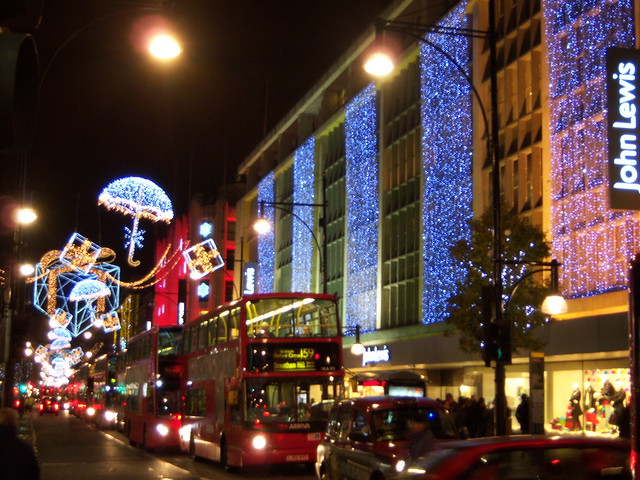
The following is a (slightly different) reprint of my recent Eye Weekly cover story I wrote after a November trip to London. I’ve included a number of (bad) photos I took of the Regent and Oxford Street holiday decorations I mention in the piece. If you followed the recent student demonstrations you’ll also recognize those lights from this video where Charles and Camilla’s Rolls Royce met British students. After reading you might also like to read a response to the article by Jason Paris.
![]()
Toronto, they say, is obsessed with New York. But these days, we may be wiser to direct our gaze back to our colonial mothership, London, England. It used to be that our fine city looked across the Atlantic for most things intellectual, cultural and political. And popstars. So many popstars. We still want the popstars, but Toronto isn’t preoccupied with London so much anymore. Instead of Queen, King, Bathurst or Islington — all mother country references — we’re more likely now to give something a local reference like Mike Myers Drive or Marshall McLuhan Way. Yet to wander London, with so many reverse-references to Toronto, is to walk around the colonial mothership that gave birth to this city. We need to know it to know ourselves.

As it happens, Toronto is almost exactly the same size (around 40km wide from suburban edge to edge). And as we swear in our new mayor, many of the very same issues plaguing London—transportation, congestion, immigration and the urban-suburban divide—have emerged, rather aggressively, as our most pressing concerns. In fact, one could argue that London and Toronto are on very similar paths—only a hundred years or so apart.
Consider the similarities. In the 1890s, there were about 5.5 million Londoners, which is close to the size of the GTA’s population today. Imperial London grew quickly during the mid-to-late Victorian era as people from all over the world migrated to the city to be at the centre of it all. Likewise, Toronto is growing today through its immigration boom, placing us at the centre of a global multicultural network.
Today, both London and Toronto are remarkably walkable and neighbourhood-based, with transit systems that have always driven development. Both are also filled with a jumble of architectural styles and have districts that aren’t traditionally “beautiful,” but are gentrifying fast.
Above all, there is a sense of economic and cultural freedom in both of these market-driven places, which are bubbling with opportunity and bursting with innovation.
I recently spent eight days in London, wandering my second favourite city (Toronto will always be No. 1 to me). What I saw when I walked the streets is that Toronto is very much still its parent’s child. Our sidewalks have London’s DNA mixed right into the concrete. Perhaps now more than ever, thinking about how London became what it is today is helpful in understanding Toronto’s own evolution into a truly global alpha city. It was also heartening to find that, in plenty of areas, the student has become the master.

1. Reach
London, historically, had an army working for it, expanding the empire and acquiring territories, all of which fed the capital. For all the racist, oppressive and exploitative faults of colonialism, London would not be the multicultural metropolis it is today without it. Good has grown out of bad, and the city’s openness to absorbing people from across its fallen empire has become one of its greatest strengths. Toronto didn’t have an army, so our empire has been created by stealth. We’ve attracted people because they simply wanted to come (the same reason people still go to London now).
The difference you’ll notice there is that Londoners are sure of themselves—they’ve been telling their own stories for centuries now. London has been the star of so much literature, historical and fictional, that it lives in the imaginations of people there and everywhere.
Toronto’s history and stories don’t seem as deep, because we’re only beginning to really tell our own stories and, for example, let Toronto be presented as Toronto in movies. This seems like a small point, but it’s a big reason Torontonians notoriously suffer from identity issues, and why looking to London or New York became so commonplace.
2. Density
The geographic parallels between the two cities are interesting. London is a lot thicker. During the day, the number of people in the streets is incredible. You can get a similarly immense urban-movement feeling in Toronto when standing over the 401 or watching a packed subway train go through a station, but London constantly feels like an anthill that somebody’s disturbed.
We’ll experience more of this phenomenon in Toronto as the population rises. Both Toronto and London are walkable places where neighbourhoods blend seamlessly with one another. Like London, and unlike many North American cities, Toronto has extended “high streets” (main streets) that have kilometres of near-continuous retail and restaurants and bars and good stuff to do. London is nearly impossible to walk through without spending money. Every block demands its pound sterling. The high streets, especially before the holidays, sparkle and shine. Above Regent St., a thick web of twinkly lights hangs like a dozen electric fishing nets, and entire buildings along Oxford St. are wrapped in lights, keeping the avenue bright well after dusk.
Giant department stores like Harrods, Selfridges and even Marks & Spencer are filled with so much stuff that they unfold dreamlike as you walk through. It doesn’t seem possible that all of these goods could ever be consumed. In Toronto, even places like Holt Renfew (which owns Selfridges now) don’t capture the wild quality of the department-store and high-street experience of London. Perhaps this is for the best: it’s easier to keep your money to yourself here, though if you’re looking to eat late in the evening, Toronto wins. London’s pubs and restaurants are shuttered early.

3. Style
Linked to its walkability is London’s dedication to the details of its streetscape. The sidewalks, lamps, rubbish bins and curbs are built with a solid elegance that is largely unknown here. Upon returning to Toronto, our street furniture seems like it’s Fisher-Price, the sidewalks rough and patchy. London invests in fit and finishes more than we do. Here, we now call spending on such things “gravy,” because we don’t yet believe we have the makings of a great world city. London knew what it was from the beginning and never forgot it.
If we care about how streetscapes look, we should care about the people walking along them, too. London is about the best-dressed place on earth—particularly in the case of men (women, wherever they are, generally know how to dress, the regrettable phenomenon of jeggings aside). The inclination here is towards formality. Clothes are tailored and everything fits. Returning to Toronto, the general frump of the population is a bit of a downer.
I also miss the sound of other people’s shoes on the sidewalk, a constant companion in London. Those nice paving stones, coupled with leather-soled shoes and proper heels, make a much better sound than the one that emerges when casual rubber soles meet poured concrete in Toronto. Walk along the new, fancy Bloor sidewalk near Yorkville to get an idea of how London sounds, but then imagine that sound everywhere—even in run-down neighbourhoods—echoing off stone buildings.
4. Movement
People drive in London and, although they complain, nobody expects it to be easy. In Toronto, we still think getting around in cars is supposed to fast and pleasant, as our newly elected conservative mayor insists it can be.
In London, they no longer have the luxury of thinking wider roads can make a difference. The city is so congested, conservative mayor Boris Johnson is pledging to make it even more walkable. His predecessor, the David Miller–like Ken Livingstone, created congestion tolls for cars entering the city centre. People grumbled, but there was no revolution and, if there was ever a war on the car declared, it was over fast.

Of course, London’s relationship to the car spans a much smaller percentage of its history. Cars have been around in Toronto nearly half as long as we have, so our allegiance to them is hard to shake. However, as our population density grows to London-like levels, we’ll come to learn what Londoners already know: that more roads just invite more cars and more traffic. London deals with congestion by building less, not more, car infrastructure.
That dense population makes it slow getting around. Really slow. In Toronto, I tend to be a bit (too) carefree about distance: if I’m late, I can take measures that will make me a bit less late (I can bike faster, run, jump in a cab). In London, there is nothing you can do to speed your journey. The city is in control and you’ll get to where you’re going when it wants you to get there. The Tube is much more extensive than our subway system—its map looks like an organized plate of spaghetti—but the speed of Toronto’s subway system is so much greater that all my TTC complaints are temporarily forgotten upon my return. I was late for every appointment I had in London, except for the ones to which I rode a bike.
Ah, bikes. A London friend gave me a key to the city’s bike-sharing scheme—not yet available to foreigners—fondly named “Boris Bikes,” after the aforementioned conservative mayor. They are similar to Montreal’s (and, soon, Toronto’s) Bixi bikes, available for short-term loan from depots across the city.
As a cyclist with my own bike, I didn’t think this kind of thing would matter to me in Toronto. But riding the Boris Bikes changed my mind. Other than walking, it was the one way I could take control of my movement around London. I’d take one a few blocks to get to the Tube station faster. Or I’d take a bus to a bike station and ride from there via a more direct route than transit would go. With 6,000 bikes spread throughout the core of the city, there tended to always be one around.
The bikes themselves are built as heavy as tanks, but they’re good for short trips. I did do two longer, late-night 10-kilometre rides across the city to avoid waiting for the night bus. If you want to be alone with Buckingham Palace, ride by at 5:30am, and it’s just you and the Queen. Everybody seemed to use the bikes, even businessmen in three-piece suits, their briefcases latched to the basket on the front, peddling along Fleet Street. The Boris Bikes are a gateway drug to a strong bike culture. One hopes Bixi achieves the same effect in Toronto—“Rob’s Rides,” anyone?
Riding in London was similar to biking in Toronto. There were some bike lanes (and even separated “bike highways”), but I didn’t know where they were or where they went, so I stuck to the roads, where bikes blend in with the traffic. Unlike in Amsterdam, where bikes rule over cars (and, it must be said, over pedestrians), the London cyclist needs to be a little tough, like a Torontonian, but he or she can flow along with traffic just fine when alert. The many bus-only lanes were good for bikes too. While I noticed a little more respect for cyclists on the roads from drivers, the experience in Toronto has a slight advantage as our regular car lanes are wider to accommodate all those big American cars.

5. Suburbs
London has a tenuous relationship with its suburbs. Downtown Londoners can be heard making snide remarks about people from surrounding areas, like Essex or Kent (the English version of the 905, they’re called the “Home Counties”). The same dynamic as Toronto exists between urban and suburban: the Home County residents vote more conservatively, live in single-family (or attached) suburban homes, drive cars a lot and shop at Tesco (the British Walmart-style retail behemoth). People in the city complain of the sprawling nowhereness of it all, the repetition, the boredom of the suburbs—if not for the accents, you could be listening to a Torontonian, as the same generalities and stereotypes are shared.
6. Gentrification
Like Toronto, and despite being so much bigger and having a longer history, London has lots of dowdy neighbourhoods with Texaco stations and food marts that are far from the shiny famous middle where Saudi Princes whiz by in Mercedes limos. This is something people forget when they see the superstar parts in the paparazzi magazines. Dozens of neighbourhoods are becoming gentrified, some slowly, some quickly, just like Parkdale or the Junction in Toronto. There are old, rundown malls in London (like the one in the middle of the Elephant and Castle roundabout) that are just like some of Toronto’s (like the Galleria on Dupont at Dufferin). They have no chain shops but are filled with ancient businesses, new immigrant start-up shops and little kiosks selling phone cards that charge only a few pence to call Mumbai.
When I went to London in 2003, I wandered around Shoreditch one night. This is on the east side of the city, traditionally working class and somewhat rundown. It felt exactly like what West Queen West did around that time, just before the Drake and the rest moved in. It was dead at night, there were few people on the sidewalks, no shops open (and many were permanently closed). Today, it’s overwhelmed by partiers on weekend nights and brunch eaters by day, just like West Queen West and Parkdale. Nearby, Old Street is known as the “Silicon Roundabout,” as it’s the location of so many web- and design-oriented businesses. The circles continue to expand and heretofore-unloved neighbourhoods become hip.
I went up to the Dalston neighbourhood north of Shoreditch, a couple of kilometres away from any convenient Tube stations. It looks like 1970s, depressed Britain and, until recently, it was never talked about by anybody other than the people who lived there. On Saturday night, though, the sidewalks were filled with what one London friend described as “the pouty people,” smoking outside of pop-up clubs. Hipsters pout the same everywhere, and they colonize neighbourhoods in the same way, inhabiting sweaty, loud basements and watching bar-top performances. The place we went was called the Dalston Superstore, like London’s version of Queen West’s Beaver—though much farther from the city core.

7. Architecture and liveability
The way London looks is almost Torontonian, too. There isn’t a considerable amount of uniformity in its architecture, nor a particular look or style. Sure, there are a lot of Georgian and Victorian buildings in the city centre, but they aren’t dominant in the way architectural styles are in other European cities—the way Paris looks like Paris or Prague looks like Prague or Edinburgh like Edinburgh. With such extensive bombing during the Blitz, huge patches of the city were destroyed and often not rebuilt for a decade or two, and when the new stuff went up, it often wasn’t in any traditional London style. So there is a mishmash of buildings: old cute stuff and, like Toronto, post-war modernism (the stuff Prince Charles is always hating on).
This kind of landscape makes for creative cities. London’s always had, and still has, a hot cultural and arts scene. Cities whose look was established ages ago are often locked into that era like museum pieces. Artists in Edinburgh complain that it’s hard to do anything new there. When was the last time Paris had an internationally known and thriving artist scene? The 1920s? Jumbled-up cities like Toronto and London are allowed to constantly re-invent themselves; they act as a kind of tabula rasa for culture to happen on.
On this last point, Toronto may have even more freedom than London. It’s a much easier place in which to live. Resources aren’t as scarce and the rent is more affordable. Londoners certainly have strategies to avoid costs, but I find I spend pounds as I move through London at the same rate I spend dollars at home (the pound is worth around $1.60 Canadian right now). It is still possible, in Toronto, to live alone in an apartment that has a room or two without making a great amount of money. In London, the equivalent situation is having a tiny room in a flat stuffed with three roommates.
8. Expansion
With the fate of Transit City an issue right now, it’s worth noting that London and Toronto have had similar growth patterns. Many of our first suburbs, parts of the city we think of as “the middle,” actually began as streetcar suburbs. Transit drove development. In London, they had what are sometimes called “Tube suburbs,” where the underground was laid and the urban density followed. Toronto’s current version of this has been the Sheppard line, the “subway to nowhere” that now goes somewhere as whole new communities have sprung up around it. Early on, the poet Shelley called London a “great sea, whose ebb and flow at once is deaf and loud,” and the Building News, at the turn of the last century, described London as having “fungus-like growth.” This is the same tone we use to describe Toronto’s development sometimes.
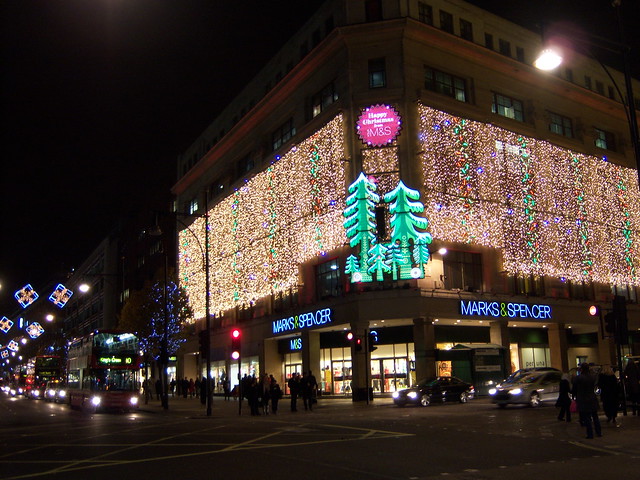
Returning home just in time to find the city immersed in a huge battle over its future—Transit City and other Fordianisms that bubbled up in my absence—I find that London’s example has quite a lot to teach us about how to grow. In finding strength in diversity, we’re already bettering London’s example by peacefully accomplishing what it did by force. If we can, as London did so well, make the polyglot population pay off by forming a political and business network upon which the sun never sets, we’ll have a serious global advantage. Moreover, we can learn from London’s big (but nice) ego, to be more—as the frat boys say—balls-out about our Torontoness. (And we should fund a city museum, too.)
At the street level, both cities contain enough block-by-block enticement is to keep people exploring, but London sparkles brighter. We shouldn’t be afraid to turn the lights up, and we should always remember that even if the gravy train doesn’t run on time anymore, God is in the details, so we ought to dress ourselves and our city to impress.
London’s larger number of transit options and lines stretching to every corner of the city are an example we should emulate, but Toronto’s system is easier and quicker to negotiate—a feature worth preserving. Still, especially as we grow, we need to know that adding car infrastructure will not solve congestion problems—London has now awoken to that reality. If you invest deeply in transit and bikes, as they have, people will still want to come into the city, and will find it less frustrating to navigate when they do.
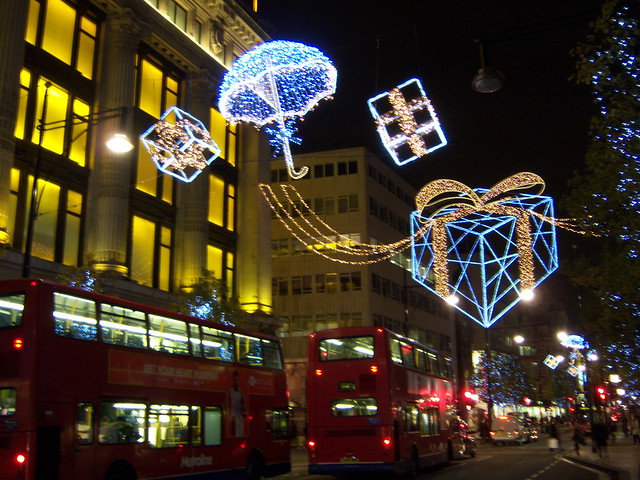
Transit infrastructure also gives London’s suburbs easy access to the city on frequent trains. Imagine being able to go to Union Station and catch a GO Train every 15 minutes to Brampton, Newmarket or Oshawa. No need to plan—just show up and there will be a train. This means that, snobbery aside, the suburbs feed the city.
And, in the suburbs and elsewhere, let’s not fret about the dowdy parts of Toronto too much, since they foster creativity and allow room for building something new. Meanwhile, it’s likely that the desirable places to play and live here are going to continue to move farther out. North York and Scarborough strip-mall bars will possibly become the places where skinny-pants-pouty-people trek to for the next fun thing. We should get used to—and get comfortable with—the inner suburbs.
There are hundreds of city-building lessons to absorb after a visit to London, but for Toronto the most valuable is a sense that we are, in some ways, already a better city than London, and that, going forward, a city the size we are now, with all our dynamics of immigration and expansion, can in 100 years occupy the status London now enjoys on the world stage. It’s a city that survived the Blitz and has survived bad mayors—or having no mayor, for a time, after Margaret Thatcher dissolved the London council in the 1980s—but still reigns as a great city, an alpha city, a leader of the world.

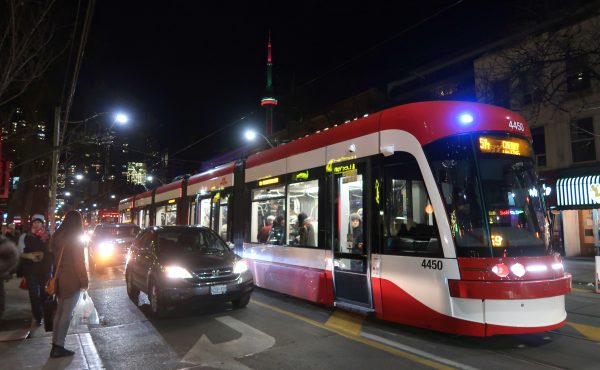
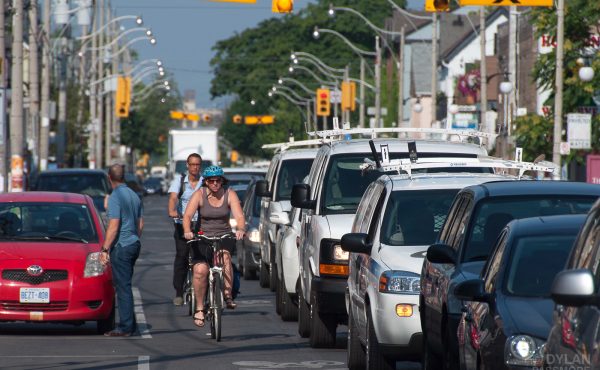

5 comments
Shawn,
Thanks for this. As someone who has lived in both cities I find it rings true, and agree wholeheartedly with your observation that the two cities have a great deal in common. Toronto and London share some very important DNA, and it’s more than just pubs and the Queen.
That said, the energy, verve, and determination with which London is charging into the future marks an unflattering contrast in the Age of Ford. The key distinction, to me, is that in the U.K. ‘urban’ issues are not, at the moment, cleaved along left-right lines. Boris Johnson was seen as a sort of Fordish buffoon before his election (OK, with a column in The Spectator, but still) and campaigned on a strongly pro-suburb platform, appealing explicitly to the ‘0208’ boroughs that felt left out under Ken Livingstone. (Like Toronto, London is now an unwieldy megacity with a vast suburban hinterland that votes in the same leader).
A lot of progressive, inner-city Londoners were appalled by his election, which even featured a ‘streetcars bad, buses good’ angle when Boris promised to kill Ken’s beloved Cross-River Tram project, and duly did so.
Yet look at what he is doing for the issues that Spacing readers care about! Between cycling and pedestrian initiatives and Crossrail, the £15 billion new central rail link that Boris is doing everything but grabbing a shovel himself to get built, he will have moved the ball forward on urbanism farther than perhaps any big-city mayor in the world in recent memory.
Now, Boris has a lot of tools at his disposal but I think the most important is that in London, as (to a lesser extent) in Mike Bloomberg’s New York, it’s possible to be a ‘big city conservative.’ That is, Britain’s right-wing opinion leaders live in Chelsea and Kensington and Knightsbridge and Notting Hill, and they would find the notion that espousing conservative ideals means you should live in a suburban subdivision with a three car garage completely ridiculous. Pedestrian amenities and cycling and transit simply aren’t left-right issues, and that allows a lot of progress on stuff that Toronto seems to be constantly gnashing its teeth over.
In this regard I think one of the most positive trends in Toronto is actually the steady flow of wealthy empty-nesters to downtown condos. That demographic includes a lot of influential people on both left and right, and if they begin to see the world from a more ‘urban’ perspective it’s only for the good. I certainly know plenty of Torontonians of a certain age of my acquaintance who have become much more attuned to public realm and transit issues since moving into a downtown condo from a midtown house.
On the whole, though, I think the main lesson of London is that Spacing-type city-builders need to do everything they can to de-politicize the issues they care about, such that no one sees, say, advocating for beautiful public spaces or safer sidewalks to be a left- or right-wing cause. The silver lining of the Ford era, I suppose, is that there will be lots of chances to try to win over conservatives.
This kind of change certainly isn’t impossible. Not so long ago Britain had a Conservative PM whose attitude to transit and alternative transportation was, basically, ‘buses are for losers.’ Now it has a Conservative PM who makes a big show of getting around by bike.
An excellent read.
One thing that I noticed and admired from my time spent in London is that they seem legitimately proud of their history, the people who built the city/country and the people who did something worth being proud of. You’re constantly bombarded by plaques, monuments, statues, etc. in London (and most European cities), which allows for a story to be told as you move throughout the city. Toronto, not so much. The idea of commemorating someone or something that played an important role in our city’s existence with something like a statue would be considered frivolous, or (more-recently) “gravy”. There really isn’t a visible sense of civic pride, even though Torontonians can be very proud of their city. People complain that we don’t have a City of Toronto Museum, and while it’d be great to have one, the city itself can tell just as good of a story if we allowed it to.
Shawn,
I lived a year and a half in (east) London and had very similar experiences to the ones you describe here; every time I go back I’m reminded of what makes the city an urban wonder, but also what makes it aggravating, expensive, and sometimes impossible to navigate efficiently.
When I arrived in Toronto from London in 1999, I felt instantly at home in the city. I quickly realized that TO had most of what I loved about London, but little of the stuff I really disliked (like mammoth Tube delays, a late ’90s reality that was alleviated fairly well by the expansion of the Jubilee line and the development of the Overground). It’s true that Toronto still lacks the kind of public transit we really need, and it’s true that we function more in spite of our civic governance than because of it, but on the whole this is a city worth celebrating, and setting it up against London is a great way to see that.
Thanks for reminding me.
Kim
I’m sure that many Londoners have commented upon how ‘Toronto reminds them so much of London’.
I’m sure..
An enjoyable post to read…but I am left feeling like 90% of these observations are so superficial as to be nearly moot. For christsake, in 1890 London was not 40 km wide, and still had 5.5 million souls (arguably more than that)–it’s an order of magnitude larger than Toronto and entirely incomparable. It will take more than time for Toronto to fit in to a similar scale–the city would need an entirely different heritage in city planning.
“Cities whose look was established ages ago are often locked into that era like museum pieces…When was the last time Paris had an internationally known and thriving artist scene?”
Um… what? Can you prove a real understanding of the “artist scene” in ANY city, if you are willing to assert this point? Paris has nearly always been a major cultural centre for millennia and in many fields far ahead of London. It thusly attracts most of the heavyweights in performing and visual arts circles even to this day (Stravinsky didn’t go to London, Prokofieff didn’t got to London, Picasso didn’t go to London, Boulez didn’t go to London). Even within Canada, Toronto’s claim to the “artist scene” ranges from tenuous to dubious–your provincial arts funders all but guarantee that.
As far as style goes…I’m sure you got around London while you were there but I’d challenge you to ride out to Bethnal Green and make the same claims.
And please…what city doesn’t have this antagonistic relationship with its suburbs?
Anyway, It’s the Toronto city booster’s greatest pitfall–earnestly claiming the rest of the world is like Toronto (or vice-versa) without bothering to admire what’s actually in the mirror. London is like Toronto. New York is like Toronto. Sydney is like Toronto. Montreal is like Toronto. Berlin is like Toronto.
It’s maddening that those are the only terms that city boosters can use to talk about how great Toronto manages to be. Toronto, in all its incoherent, awkward glory, is a lovely, dynamic city without being much like London, or anywhere else for that matter.